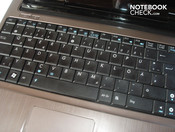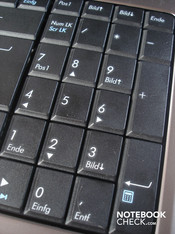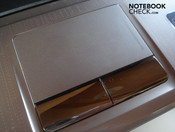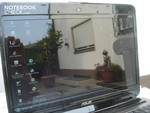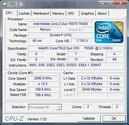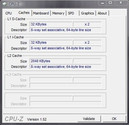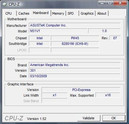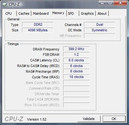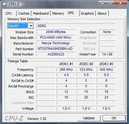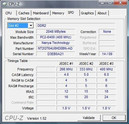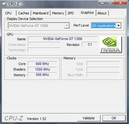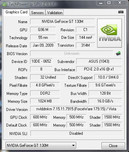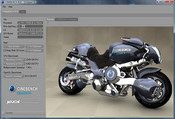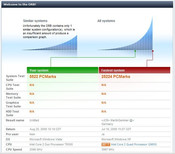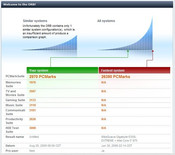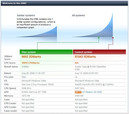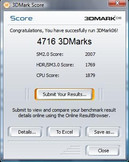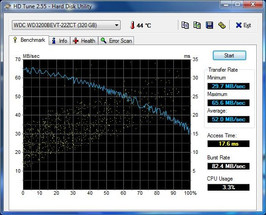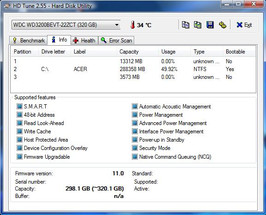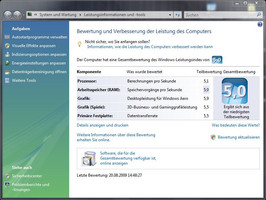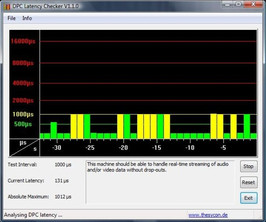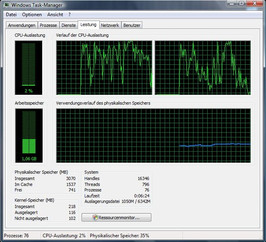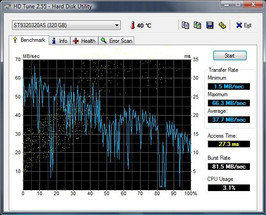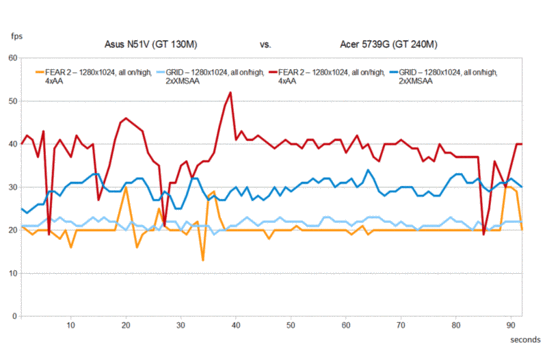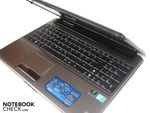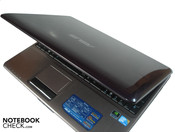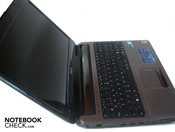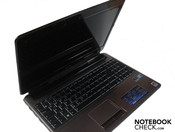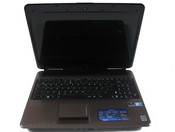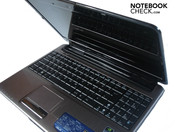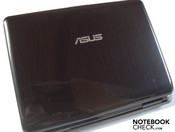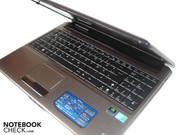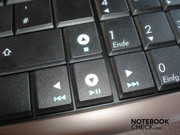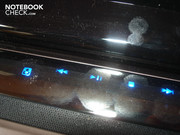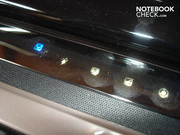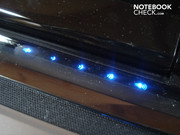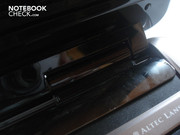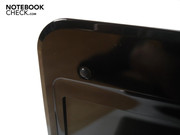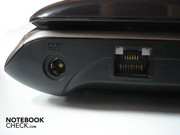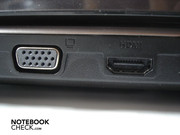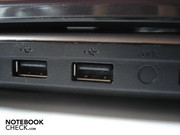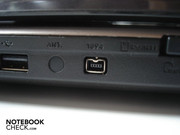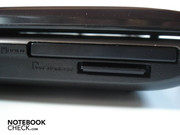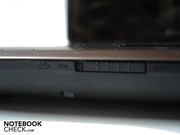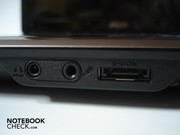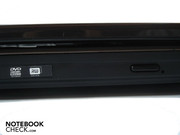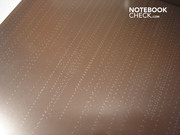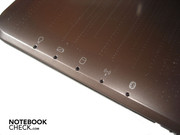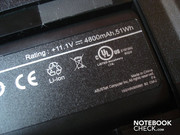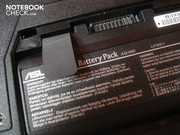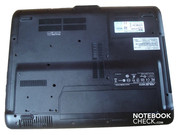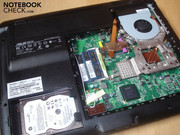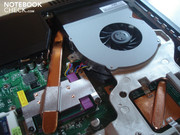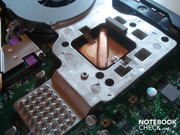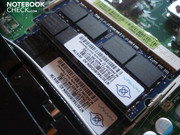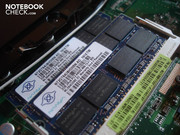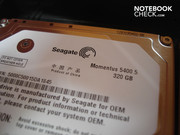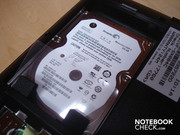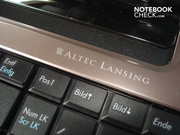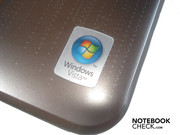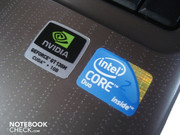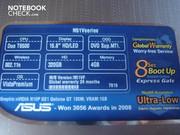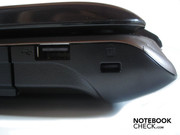Review Asus N51V Notebook
All in One?
Asus sends a pricely attractive all-round notebook into the race with its N51V, which promises good performance values with a Core 2 Duo T6500 processor and a Geforce GT 130M graphic card. In connection with a 16:9 LED HD display, it seems to be interesting for hobby gamers as well as multimedia users. We have taken a closer look at the N51V and benchmarked it extensively.
Asus considers its N51 series as pricely attractive all-round notebooks. The N51Vg, which has a Core 2 Duo and a relatively inefficient Geforce G 105M, can already be acquired at a starting price of about 650.00 Euros. Then the about 700.00 Euros expensive N51Tp follows, which is equipped with a Turion 64 processor from AMD and an efficient ATI Radeon HD 4650. We have taken the N51Vf, priced at about 750.00 Euros, which has a Core 2 Duo T6500 and a Geforce GT 130M. The N51Vn, which is available at a price starting at about 800.00 Euros, wraps up the line. This then has a Core 2 Duo processor, but uses the efficient Geforce GT 240M as a graphic card.
Case
The 15.6 inch case weighs a good 2960 grams and has the dimensions of 369mm x 276mm x 43mm (breadth x depth x height). The case is designed very colorfully. The glossy display lid presents itself in a mixture of blue, black and gray, whereas the coloration varies a bit depending on the viewing angle. Additionally, the lid as well as the wrist rests are provided with a chic texture. This looks like raindrops that trickle down a window, leaving dozens of smaller drops behind. Unfortunately, the display lid tends to pollute rather intensely. The black display bezel and the touch-sensitive bar gathers fingerprints just as fast, as both are kept in a high-gloss design. The upper side of the case finally shimmers in a metallic looking gray-brown and therefore makes a rather qualitative impression. Looking closer, it becomes evident that mainly plastic has been used.
In view of design, the case is extremely tapered towards the back and makes a rather roundish impression because of its soft curves. That definitely won't suit everyone and we would have also preferred a clearer and "edgier" line management. Furthermore, the comparatively thick display frame annoyed us, which has turned out rather wide on the vertical axis.
As to the case's stability there is barely anything to be criticized. There were scarcely any graphic errors to be provoked even at stronger pressure. The upper and bottom case's side didn't give in much, either; merely the battery slot rattled insignificantly at contact. Contrarily, the keyboard's stability is rather modest. This already gave in at fairly light pressure and let itself be bent strongly downwards in the area of the numerical block, as the DVD burner sits underneath this.
The massive hinges execute their job stability, but attract attention every now and then with a disagreeable grinding and creaking noise. The case also swings along slightly at opening, despite its own high weight. We found the case basically very pleasing, except for the poor keyboard's stability and the somewhat unusual design.
Connectivity
In regards to connections, there is only good news. The N51V has close to everything that a multimedia heart desires. Starting on the left, where a RJ-45 Gigabit LAN port waits beside the power socket. A VGA and an HDMI output for connecting external monitors follow. Two USB 2.0 ports and a Firewire port succeed. An opulent 8-in-1 cardreader, which is proficient of the formats SD, mini SD, MMC, MS, MS Pro, MS Duo and MS Pro Duo, is conclusively placed beside these.
On the front, there are only two sound sockets to be found (headphone-out, microphone-in) and an eSATA port. On the right you finally find a multi-norm DVD burner, a third USB 2.0 port and a Kensington lock. There aren't any ports on the back side whatsoever. A wireless link is built up over the integrated WLAN 802.11 a/b/g/n.
Overall, the interface positioning pleased us. The most important cables are unitedly placed beside one another on the left side. Lefties could have a hard time with this circumstance. Only the sound ports and the eSATA in the front side's center might be, in our opinion, a bit displaced, as plugged in cables might turn out to be annoying when in use.
Otherwise, the N51V also has a 2.0 megapixel webcam and an integrated microphone. The integrated "Express Gate" proves to be a treat. A push of a button doesn't boot Windows, but a mini-operating system instead, which makes numerous operations possible, anyway. A web browser has been integrated, there is the possibility of rendering music and photos and various online games are available (on a certain online platform). Additionally, there is the possibility of using Skype and other instant messaging programs. The speed via Express Gate is very good and the use is also intuitive and simple. So hose who want to quick check their emails or look at the pictures of the previous holiday are at the right address here.
Input Devices
Basically, a standard layout is used for the keyboard. The keys have an agreeable size; merely the arrow keys and the keys of the numerical block have turned out to be a bit narrower than the others. However, the keyboard couldn't impress us at all.
As already mentioned, it gives in quite strongly to a part and the pressure point is rather indistinct. The angular key form also annoyed us after a while and the clattering, which the keys emitted at use, didn't really make an impression of quality.
We liked the touchpad quite a bit more, though. The surface is relatively smooth but in return the gliding traits turned out to be pleasant. The touchpad has a marked scroll bar. This doesn't work perfectly though, as the actual scroll area is a bit beside the marking, which results in the intended scroll function not being executed. Also, the scroll function has been screened in rather stiffly and barely lets itself be maneuvered precisely (despite diverse tested driver settings).
Contrarily, the mouse keys work perfectly. But then there are two minor flaws. On the one side, the pressure point is almost too distinct and on the other, the noise at clicking too loud for our taste.
Asus has placed a rather inconspicuous touch screen bar above the keyboard. This has, aside from the usual multimedia functions such as a toggle volume control, further functions, which are worth a mention.
Thus, the energy saving modes can be interchanged via "Power4Gear", which react partially different than those known from Vista and is supposed to save even more energy. Then, you can adapt the image to various scenes such as "Vivid" or "Theater" with "Splendid". This is followed by a function to deactivate the touchpad. Lastly, the "Ionizer" is to be mentioned. According to Asus, this unusual technology is to supposedly "provide for a cleaner and fresher work environment", cleaning the air from bacteria and provides for a better air circulation. Subjectively, we didn't notice anything in this way. Everyone has to decide for themselves what they think about such "marketing promises".
What did annoy us even a bit more was the poor response of the bar with touch-sensitive buttons. A fairly strong and long pressure is needed in order to trigger the single functions. A further problem: Even if you have accustomed yourself to the unusual response, it happens often enough that the bar with touch-sensitive hotkeys doesn't react at all.
Display
Asus deploys a 15.6 inch HD screen with a resolution of 1366 x 768 pixels as a display. The N51V has a good luminance of an average of 253 cd/m2 due to the LED backlight among other things. The brightness stays continuous in battery mode, by the way. The illumination of 79% can also still be described as reasonable. The low contrast of 131:1 and the very high black value of 1.92 cd/m2 is insufficient, though. Subjectively, the display seemed to be adequately bright, but very pallid and lacking color in our opinion.
| |||||||||||||||||||||||||
Brightness Distribution: 79 %
Center on Battery: 252 cd/m²
Contrast: 131:1 (Black: 1.92 cd/m²)
The viewing angle stability is also everything else than worthy of reference. Thus, discolorations quickly turn up especially in the vertical field, as it can be seen on our "Viewing Angle" picture.
Performance
Asus has gone for a balanced mixture of mid-range products for the components. A Core 2 Duo T6500 processor with 2.10 GHz is deployed for the CPU. This has a good 2 MByte L2 cache and runs with 800 MHz FSB. There are also four GByte DDR-6400 RAM on Intel's PM45 mainboard. The two RAM slots are already fully occupied with 2 x 2 GByte, and the maximum memory capacity is already reached with 4 GBytes. Due to the 32 bit operating system (Windows Vista Home Premium), there are merely about 3 GBytes available, though.
Asus uses the Geforce GT 130M from Nvidia. This has 32 stream processors and an opulent 1 GByte DDR3-VRAM. The GT 130M additionally supports DirectX 10.0 and has with PureVideo HD a technology for decoding high resolution video material. The graphic card runs with a clock rate of 600 MHz (core), 500 MHz (memory) and 1500 MHz (shader). In view of performance, it lies slightly over the older Geforce 9600M GT, theoretically, but still far below the new Geforce GT 240M and the competitor card from ATI, the Radeon HD 4650, which is used in equally priced notebooks.
Let's now look at our benchmark course and start with the CPU-biased benchmarks. The N51V reaches a good 2249 points in the single and 4262 points in multi core rendering in Cinebench R10. In the OpenGL benchmark it achieved 3013 points. For comparing: A Core 2 Duo P7350 (2.00 GHz, 3 MByte L2 cache, 1066 MHz FSB) reaches slightly lower results with 2141 points in single and 4036 points in multi-core rendering. The N51V reached 5522 points in the PCMark05; in the PCMark Vantage it was enough for 2970 points. A P7350 achieves slightly lower, respectively somewhat higher, results with a similar configuration of 5377 points in the PCMark05 and 3440 points in the PCMark Vantage.
On it goes with the GPU-biased benchmarks. The N51V still achieved a good 9692 points in the 3DMark05. In the 3DMark06, the N51V then had problems to present smooth scenes on the display earlier, which also then resulted in only 4716 points (CPU: 1879 points). The notebook was then completely overexerted with the 3DMark Vantage and only achieved a total of 1595 points, whereas 1326 were for the GPU and 4084 for the CPU (without PhysX). A Geforce GT 240M, which, for instance, had been previously tested and is used in an about equally priced Acer 5739G, reached a much better result in the 3DMark Vantage with 2348 points.
A Seagate hard disk with a capacity of 320 GBytes and 5400 rpm is deployed as mass storage device. We have assessed its results with the Tool HDTune. Thus, the minimum transfer rate was 31.7 MB/s, the average 51.8 MB/s and the maximum 69.4 MB/s - overall good values. The access rate of 22.3 ms turns out to be rather under average. The given performance is fully adequate for a normal work day, though.
The Windows Vista performance index isn't very expressive on the whole, but will be mentioned now, anyway. The index awarded 5.1 points to the CPU, 5.0 points to the RAM, 5.9 points to graphics, 5.5 points to graphic (games) and 5.5 points to the hard disk. Therefore, a more efficient CPU or RAM would boost the system's performance a bit.
With help from the DPC Latency Checker tool, we checked the latencies in Windows. This is insofar interesting, as too high latencies could cause problems when external devices, such as sound cards, are connected. We can give the all clear signal in this case, because the highest latencies are reached in an area of 1000 µs.
Two negative things, however, were noticed in the N51V and should be mentioned in any case. First: numerous, superfluous programs and tools cause a minimized performance, especially during and after the system start, in the state of delivery. Thus, the system capacity swayed in a range between 0 and 100% for several minutes after the booting process. However, cleaning the installation from various, unnecessary programs, makes this problem to a thing of the past for the largest part.
During our tests, the hard disk also provided for an unpleasant shock moment. It suddenly began to rattle loudly after a booting process. As Windows then was finally booted after half of an eternity, the operating system reacted unusually slow. We started a HDTune once again and see there: Suddenly the transfer rate swayed enormously and the access rate increased considerably in comparison to our first measurement (see screenshot). After a further booting, the hard disk's rattling was gone and the hard disk seemed to work properly again. The emphasis is, however, on "seemed" because the results of the HDTune were still even worse than before this incident. We couldn't establish the exact reason for this conduct to the very last.
| 3DMark 2001SE Standard | 20959 points | |
| 3DMark 03 Standard | 15171 points | |
| 3DMark 05 Standard | 9692 points | |
| 3DMark 06 Standard Score | 4716 points | |
| 3DMark Vantage P Result | 1595 points | |
Help | ||
| PCMark 05 Standard | 5522 points | |
| PCMark Vantage Result | 2970 points | |
Help | ||
Gaming Performance
There are dozens of multimedia - respectively all-round notebooks, which romp about in the price category of 800 Euros, and which partially have a surprisingly efficient graphic card. In order to evaluate the Geforce GT 130M's efficiency even better, we have compared it with both the brand new Geforce GT 240M and the, in the meantime, favored Radeon HD 4650.
We'll start with games, which have an integrated benchmark:
Counter Strike Source & Half Life 2 Lost Coast
As it was to be expected, older games aren't a problem for the GT 130M. We ran the benchmarks for both in high details and with a resolution of 1024 x 768. CSS achieved an average of an enormous 207.3 fps, whereas HL 2 still ran with a very good 125.6 fps. Even the Geforce GT 240M was almost neck on neck.
Call of Juarez
A different picture was shown for Call of Juarez. The N51V studdered along with an average of 11.4 fps in the resolution of 1024 x 768, 4xMSAA and high details, whilst a GT 240M computed more than three times as fast with 35.6 fps. The HD 4650 is also greatly quicker with 33 fps.
World in Conflict
The showcase strategy game World of Conflict also puts the GT 130M in its place. High details, 2x AA, 2x AF and resolution of 1024 x 768 expressed themselves in an unplayable 15 fps. To be said in defense, other graphic cards have a hard time with this game, too. However, the HD 4650 makes an even better figure here.
The tracks that we have measured in-game with the Fraps tool follow now:
Quake 4
The veteran, Quake 4, only evoked a weary smile from the N51V. Quake 4 sashayed over the monitor with an average of 56.7 fps even in ultra high details and a resolution of 1024 x 768.
Left 4 Dead
The GT 130M was even faster in Left 4 Dead. Very high details and a resolution of 1024 x 768 ran with an average of 63 fps extremely smooth. As in the other tracks, which are based on Valve's Source-Engine, the GT 240M is barely faster with 66 fps.
Call of Duty 4
Even Call of Duty was well playable with 37.3 fps in high details, 4x AA and a resolution of 1280 x 1024. In comparison: A Radeon HD 4650 achieved a somewhat better result of 43 fps in the same settings.
Fear 2
FEAR 2 was the last ego shooter in this mission. The GT 130M slowly came to its limits here. In high details, 4x AA and a resolution of 1280 x 1024, merely 21.0 fps were still possible. Both the GT 240M (39 fps) as well as the HD 4650 (43 fps) are about twice as fast. The N52V allowed for a smooth gaming experience with an average of 40.3 fps at medium details, 2x AA and a resolution of 1024 x 78.6.
Race Driver Grid
Our only race game was, similar to FEAR 2, only smoothly playable in lowered details. Thus, 40.5 fps were possible in the resolution of 1024 x 768 and medium details. Grid studdered along with an average of 21.6 fps in the resolution of 1280 x 1024, 2xXMSAA and high details in comparison. The GT 240M runs properly with 29.7 fps in high details and the HD 4650 even considerably faster with 40 fps.
Anno 1404
The brand new Anno 1401 demanded everything of the N51V. Thus, very high details, 4xAF and a resolution of 1280 x 1024 with an average of 14.8 fps looked rather more like a slide show. Even in high details and without anisotropic filtering, Anno studdered unplayably with 21.3 fps. The GT 240M outstrips this result even in very high details: 21.8 fps.
Conclusively it is to be said that the Geforce GT 130M is very well efficient enough to conjure up older tracks at maximum detail smoothly on the display and computes almost just as fast as significantly stronger graphic cards. The tide turns for newer and more demanding tracks, though. Thus, the GT 130M is usually overexerted with high details, whilst other graphic cards like the GT 240M or the HD 4650 compute considerably faster. Those who would like more information about this can simply visit out comprehensive notebook graphic card comparison and our gaming list.
Emissions
System Noise
The N51V impresses to a great extent in regards to noise development. Thus, the notebook is only slightly audible with a constant 33.2 dB(A) in idle mode. The hard disk does its job barely louder with 34.2 dB(A). The soundscape increases to 35.4 to a maximum of 41.6 dB(A) under load. The notebook might be audible, but is still rather quiet. We especially liked the quiet fan, as it scarcely changes the rotation velocity and turns out very agreeable in view of its frequency range. Only the DVD drive isn't a pussyfooter. At DVD rendering it already gets quite loud with 37.8 dB(A), at data access the noise level even increases to a disturbing 48.2 dB(A).
Noise Level
| Idle |
| 33.2 / 33.2 / 33.2 dB(A) |
| HDD |
| 34.2 dB(A) |
| DVD |
| 37.8 / 48.2 dB(A) |
| Load |
| 35.4 / 41.6 dB(A) |
 | ||
30 dB silent 40 dB(A) audible 50 dB(A) loud |
||
min: | ||
Temperature
There is a bit more critique for the temperature development. The notebook heats up to a maximum of 30.3°C on the bottom side in idle mode (two operating hours, incl. maximum energy savings options). The upper side stays marginally cooler in the area of the wrist rests with a maximum of 29.9°C. The temperature rises considerably under load (one hour Furmark + Prime95). Especially the area around the louver heats up, which is placed on the back side's left. This is reflected with a maximum of 43.3°C on the bottom side. The upper side stays slightly cooler with 40.1°C. But this is barely noticeable; there is a definite heating up felt after a short time only if you place the N51V on your thighs. The temperature of the wrist rest rather irritated us, which might turn out to be a bit unpleasant with a maximum of 35.5°C under load.
Let's take a look under the N51V's hood. We can see that all components are always sufficiently cooled. While the CPU reaches about 35°C in idle mode, it's a high, but still disalarming, 65°C. It looks very much the same for the graphic card. The GT 130M reaches around 55°C in idle mode, whereas a fairly high, but not at all alarming 85°C are reached under full load. The hard disk always stays with 40 - 45°C within a limit. In return, the adapter doesn't stay within a limit at all. This heats up to an unbelievable 65.8°C under load.
(±) The maximum temperature on the upper side is 40.1 °C / 104 F, compared to the average of 36.9 °C / 98 F, ranging from 21.1 to 71 °C for the class Multimedia.
(±) The bottom heats up to a maximum of 43.3 °C / 110 F, compared to the average of 39.1 °C / 102 F
(+) In idle usage, the average temperature for the upper side is 28.5 °C / 83 F, compared to the device average of 31.2 °C / 88 F.
(+) The palmrests and touchpad are reaching skin temperature as a maximum (35.3 °C / 95.5 F) and are therefore not hot.
(-) The average temperature of the palmrest area of similar devices was 28.8 °C / 83.8 F (-6.5 °C / -11.7 F).
Loudspeakers
The N51V has two small loudspeakers from Altec Lansing, which are placed above the keyboard. Unfortunately, the sound stays, like in most notebooks, unsatisfactory. The tone range sounds poorly mixed: Basses are barely existent, trebles are far too over layered and quickly fray. Additionally the sound is extremely tinny and the weak bass is very indistinct. It's almost a relief that the maximum volume turns out rather low. The sound is significantly better when the notebook is connected to an external system, even if it's a bit dull and not quite as crystal clear as you might wish for.
Battery Life
The battery life left back mixed feelings. The maximum runtime with minimum brightness and maximum energy savings mechanisms is a good 3 hours and 46 minutes (BatteryEater Reader's test). It still achieved 2 hours and 30 minutes at surfing via WLAN with maximum brightness and medium energy savings settings. The N51V ran out of power already after 1 hour and 50 minutes with maximum brightness at DVD rendering. The six cell battery (51 Wh) then was burnt out considerably under full load. Windows departs itself already after 1 hour and 16 minutes (BatterEater Classic test).
Of course, we also established the power requirement. The N15V permitted itself between 13.6 and 19.9 watts in idle mode. With the preset Asus screensaver it was even 29.5 watts!! The power requirement increased to 53.6 up to 72.6 watts with load. The power consumption also turns out fairly high in standby mode (0.8 watt) and in a deactivated state (0.4 watt).
| Off / Standby | |
| Idle | |
| Load |
|
Verdict
Generally, we took a liking to the Asus N51V. The design is well-executed and the connectivity is impressing in its variety. The temperature development and the gaming performance was alright too, due to the halfway capable Geforce GT 130M, whereas there is still a lot of room for improvement. Most of all, we liked the low noise development, though. However, we didn't like the mediocre battery life and the keyboard, which deflects notably, as much. The largest critique goes to the poor sound and the disappointing display with its low contrast and high black value.
Those who are looking for an all-round notebook, which is capable of all sorts of application scenarios, can definitely take hold of the N51V. For those looking for a notebook with a better sound quality and better performance, particularly in view of games, should take equally priced alternatives like, for instance, the Acer Aspire 5739G.


 Deutsch
Deutsch English
English Español
Español Français
Français Italiano
Italiano Nederlands
Nederlands Polski
Polski Português
Português Русский
Русский Türkçe
Türkçe Svenska
Svenska Chinese
Chinese Magyar
Magyar




